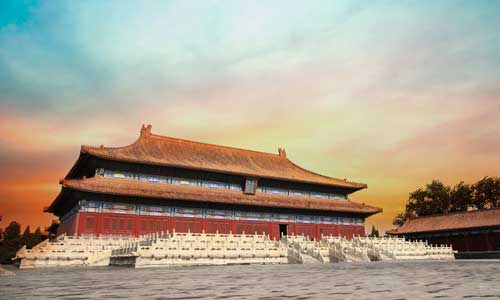
Confucian rationality concentrates on concern about the harmony and stability of the order of man's world. It adopts the attitude of trying as far as possible to evade the illusory divine world. The Analects say Confucius never spoke about ghosts and gods. When asked about Such things, he invariably responded by asking: Since things on earth have not been properly done, how can we think of ghosts and gods? He actively reminded people of the need to pay attention to man's affairs. But limited by the low development level of ancient science and the social situation, the emergence of concepts about the deity were only natural. As early as the prehistoric age, there had been worship of natural gods and ancestors, which thus developed into a primitive religion. China is an early-maturing society but this primitive worship was retained when it entered into a civilized society, and was carefully transformed by the Confucian school and thereby intensified. The imperial authority was set of f by religious authority and clan power, which thus became an important spiritual pillar safeguarding the feudal hierachy. Therefore, Confucius paid great attention to the worship of natural gods and ancestors. He said so long as we properly handle the major aspects of worship, it would not be difficult to administer the state. This precisely was an expression of the Confucian spirit of going out into society.
The sacrificial methods of these two types of worship are often different. Generally speaking, the worship of ancestors was done mostly in "temples", such as , Kongmiao(Confucian Temple) and Guandimiao. It was often called an ancestral hall, Such as Sima Qian Ancestral Hall , Wuhou Ancestral Hall, as well as wise men's ancestral halls and clan halls. Ceremonies for worshipping the natural god were held mostly on a high terrace in the open, called an "altar", such as Tiantan (Temple of Heaven) , Ditan, Ritan, Yuetan and Altar of Land and Grain. But some natural gods were more personified, and worshipping was often performed indoors. But the site was also called a temple, Such as Daimiao, temple for worshipping the Taishan Mountain, and the Zhongyuemiao, for worshipping Songshan Mountain. When put together they became "altar and temple", a type of architecture unique to China. They were different from both religious temples and from palaces directly used for human existence. Altars in residences or gardens could be regarded as a para-religious building, while a temple, in most cases, has the meaning of a memorial hall.
The religion prevalent in China was mainly Buddhism spread into China from India during the first century. Buddhist structures included Buddhist temples and pagodas, and attention should be paid to the following characteristics: (1) Compared with Christianity in relation to the West, Buddhism in relation to China has never risen to the mainstream position commanding the thought of the whole society. In China, there has never emerged a papal system, as the sovereign descends into the world, and the heart of the supreme domination has consistently been the monarch. Both China and the West preached that divine right of kings, but the West placed great emphasis on "charistmatic", while China put greater stress on "monarchical right", and the divine right was only added a sacred element to the existing monarchical rule. This difference was also reflected in buildings. For a long time, the West has taken temples or churches as the mainstream, while China has always taken place and capital city as the center of gravity, and the religious Taoist temple was placed in a secondary position. (2) At the beginning of the spread of Buddhism, the Chinese people began to transform it so that it carried a distinguishing Chinese characteristic in the course of its development. Therefore, from the very beginning, Chinese Buddhist architecture was not a simple transplantation of Indian architecture, but mainly China-s own creation. (3) Chinese religious architecture was also very different from the Western one in artistic character. The latter emphasized the "expression" of believers- passion and fanaticism aspiring to a Place in the Kingdom of Heaven. Therefore, the mysterious shadow changes, the unexpected figure, the domineering kinetic potential and the turbulent atmosphere became the keynote of its character. The former, however, emphasized the "reappearance" of tranquility and peace, nirvana. The temple should be the epitome of Sukhavati of the Kingdom of Heaven on the ground, and although this is bound to be accompanied by a certain mystery, the warm, beautiful and strong fragrant courtyard, the stretching and gentle bodily form and the easily approachable volume all give Chinese Buddhist architecture in most cases an atmosphere of serenity and affinity. (4) Chinese Buddhist temples have many points in common with residences and palaces. They both adopted the method of group combination with the courtyard as the main form. They are unlike Western churches, which are totally different from residences or palaces. Taoism is China's native religion. Taoist architecture is reflected in the Taoist temple, usually patterned after Buddhist temples.
